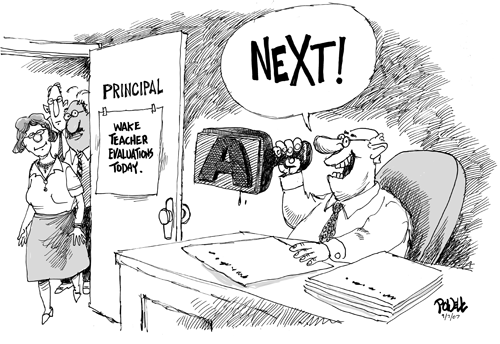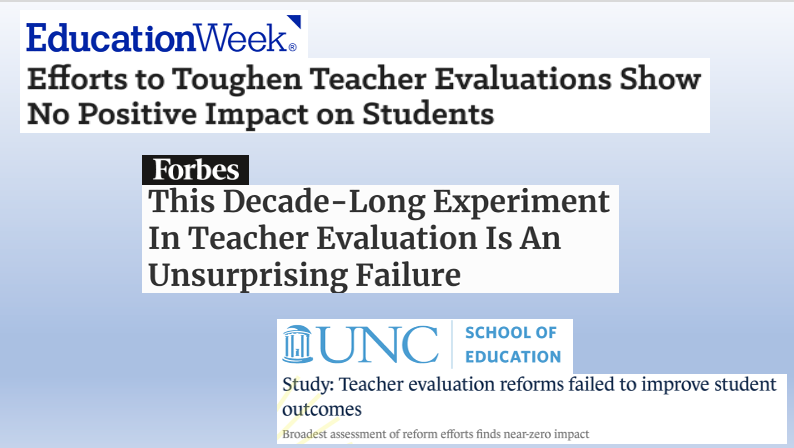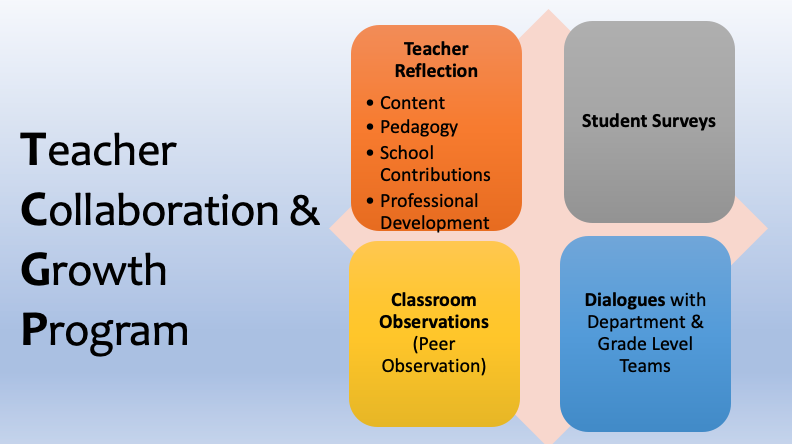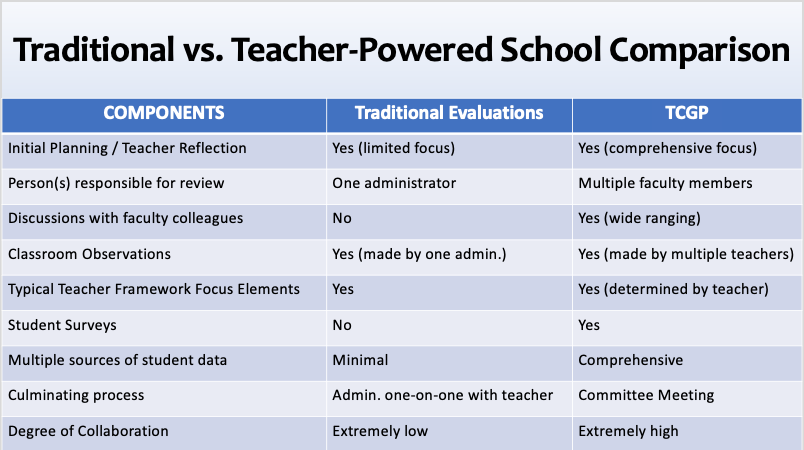Peer observation and collaboration succeed where top-down reforms fail.
This is the first of a two-part set of articles on Teacher Evaluation. Contact Greg Fisher at schoolempowerment@gmail.com.
Teacher Evaluation is at an inflection point.
There is a growing realization that the mandated process is perfunctory, flawed, and meaningless. If the purpose is that teacher evaluation is to improve teaching and learning, then it has not met its intended goals. If the purpose is to weed out substandard teachers, again, it has not delivered as districts and unions use their respective leverage, resulting in retaining virtually all teachers, regardless of teacher effectiveness or lack of it.
Yes, complex rubrics that are based on sound instructional elements have been created. But they use abstract language and are used to make superficial evaluations more efficient with their checklists coupled with the fact that those doing the evaluating and gathering evidence are inadequately prepared to observe teachers in the classroom.
Administrators, who are somehow assumed to have more expertise at classroom observations than teachers, make their scheduled visit and take a snapshot of a lesson. Not exactly the most dynamic and comprehensive evaluation process. Add in student achievement now being tied to teacher evaluation, recent social-political cultural curriculum battles directly impacting school boards and school sites, health dynamics (e.g., virus trifecta of Covid-19, Influenza, RSV, etc.), a growing student mental health crisis, and gender dysphoria issues. Oh, and throw into the mix teacher burnout. What you have is teachers now being tasked with possessing a varied and sophisticated skill-set that can address not just students’ academic needs but also the plethora of other social ills that enter into the school’s orbit, for which they were not trained for.
It’s like being the president of the United States. Too many responsibilities and unrealistic expectations for one person.

So, with all that teachers are being asked to attend to coupled with the limited and meaningless scope of traditional teacher evaluation systems, how can we reform and improve the process? What can be done to stay focused on improving teacher effectiveness that will move the needle on student achievement, mitigate those forces interfering with the learning process, and elevate teacher morale? Of course, we want to hold all adults entrusted to be spending so much time shaping the hearts and minds of our children to high standards? But let’s balance this with the value of non-judgmental support, ongoing learning, continuous growth, and collaboration. What we want is accountability and quality as well as development and improvement.
Teacher evaluation matters because it has the potential to lead to increased teacher effectiveness and positively impact student achievement. However, in terms of teacher evaluation, generally all reforms have failed to lift student achievement. The failure resulted from top-down policy reforms, not meaningfully different than the status quo, highly dependent on a change to the behavior of key actors (namely the principals and teachers responsible for student performance). Moreover, there were unintended consequences of driving down job satisfaction among educators and imposing burdensome demands on administrator’s time.
Basically, when all you have is a hammer, everything looks like a nail.

We know that teachers are the greatest resource in every school. Teachers have the greatest impact on student achievement. Effective teaching is the leading indicator for improving student performance. So, the most effective evaluation model will show measurable correlations between the model’s individual strategies and teacher development. This is why a formative evaluation process or Peer Observations is a superior way for teacher to be evaluated.
To address all of these issues and to elevate teaching as a profession, we have created the ‘Teacher Collaboration and Growth Program’ (TC&GP). The main components include:
- Teacher Reflection on content, pedagogy, school contributions, and professional development. Multiple sources of student data on academic progress are analyzed.
- Student Surveys on teaching and learning. Unleash student voices on their learning experience.
- Dialogues with Department and Grade Level Teams (using the teacher reflection content).
- Peer Observations as the primary process for teacher evaluation with colleagues providing feedback on instructional methods.

The goals of Peer Observations are:
- Improvement of teachers’ personal approaches to curriculum delivery of classroom instruction based on feedback from peer observations.
- Teachers demonstrate a commitment to continuous learning, gain confidence in becoming a successful teacher, increase efficacy by making a difference in the lives of every student, and to engage in teacher practices by using evidence-based instructional strategies.
- Identifying areas in teaching practice with particular merit or in need of development.
- Every teacher values classroom observation as a powerful tool for personalized and authentic professional learning.
- By learning from and with each other, teachers and their colleagues begin to build meaningful communities of collaboration focused on the “real world” of teaching and learning in practice.
- Teachers share strategies and best practices on addressing students’ Social-Emotional Learning.
To help cultivate trust among the staff, it is important to implement a sustained and ongoing professional development that touches on creating group norms, team building, having Better Conversations (Listening, Questioning, Empathy, Dialogue), and discussions on organizational change and how to manage the culture shift. When any organization moves from top-down to collaboration and from isolation to connection, proper coaching is necessary to facilitate the process.

If you are a Teacher-Powered School, on your way to becoming one, or even have elements of moving in a teacher-centered direction, here are reasons why you should seriously consider implementing this program:
- It’s a granted autonomy (depending on collective bargaining contracts) for most teacher-powered schools. Autonomy is independence. Independence is power. Power is freedom. Freedom is creativity and innovation.
- As a profession, teachers should be consulting with one another like other professions (doctors, lawyers, engineers, etc.). Think of the respect we can gain from that.
- Takes the responsibility out of the hands of administration and places it with the faculty school wide. Reflects a more horizontal governance structure.
- It separates you from traditional schools in the most fundamental way. Top-down decision-making is replaced by a flat, horizontal system. This empowers teachers and catapults them light years ahead of most of their counterparts in schools which are weighed down by complacency, inertia, and factors that cause a resistance to change.
- Why conform only to your district’s policies if you don’t have to? Simply add layers of collaboration to your existing teacher evaluation program when you get your staff on board.
As a high school teacher and principal working in inner-city schools in Los Angeles and Long Beach, California, I had been on both sides of the teacher evaluation process. When given the opportunity to help design a teacher-centered process that essentially replaced the district’s (Long Beach Unified School District) formal teacher Evaluation system at California Academy of Math and Science (CAMS), I jumped at it. After implementation of the new teacher evaluation program, the school took off. It is now ranked 14th nationally. The administrators were freed up, teachers collaborated in ways once thought unimaginable, and multiple measures of student achievement data skyrocketed.
Then as I helped create a high school (Humanities and Arts Academy of Los Angeles) and became its Principal, I transplanted the program and made a few refinements. It is now a model Pilot School in LAUSD and has a teaching staff using its granted autonomy who wouldn’t want to be working anywhere else and a student body that has a sense of belonging in a caring learning community where collaboration is highly valued. FYI, every teacher who has been through the program since its inception in 2000 claimed they never want to return to the district’s teacher evaluation system.
All schools are created by people cooperating to accomplish the same mission: to educate their students. They exist, and are energetically favored in nature, because teachers working together can accomplish way more than they could separately, as long as they can effectively communicate and collaborate. The bottom line is that when teachers unify and are given the freedom to support and collaborate with one another, everyone benefits. In schools where teachers are empowered and have more input on the decision-making process, assuming they are wired to be part of a team, they are more likely to plant roots at their school, they report feeling more supported and connected by their colleagues, and they become more productive as they learn and grow from one another. They are on a collective mission which translates into doing what is right for the entire student population, not just the ones in their respective classroom.
It’s time to use teacher evaluation as a vehicle for creating collaboration and growth.
###
 NEWSLETTER SIGN-UP
NEWSLETTER SIGN-UP



